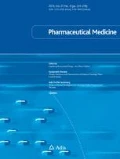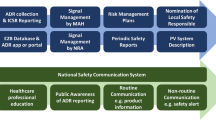Abstract
In Europe, a new guideline on good pharmacovigilance practices–Module II: Pharmacovigilance system master file (PSMF)—was issued, and initially came into effect on 2 July 2012, with revision on 12 April 2013. The guideline describes the PSMF, which is a detailed description of the pharmacovigilance system and supports/documents its compliance with the requirements. Establishing and maintaining a PSMF is a global activity. However, because of differences or absence of regulations, legislation or guidance documents (soft laws) across the globe, definitions of studies may be different. However, as part of the PSMF, the marketing authorisation holder in Europe should be able to produce and make available a list including data arising from all study sources (the so-called ‘study list’) for inspection, audit and Qualified Person responsible for Pharmacovigilance oversight. For medicinal products authorised in Europe, this study list should describe, on a worldwide basis, the status of each study/programme, the applicable country(ies), the product(s) and the main objective. Most importantly, it should distinguish between non-interventional and interventional studies (clinical trials) and should be organised by active substance. The study list should include all ongoing studies/programmes as well as all studies/programmes completed in the last 2 years and may be provided as an annex to the PSMF or separately. This article analyses the global impact of the new European PSMF requirements, with special focus on the mandatory global study list. There are distinct differences between biomedical research, market research, patient support programmes and non-interventional and interventional studies, and a decision tree to support classification is proposed. This decision tree should improve harmonisation of study assessment and minimise inter-country variability in the presentation of studies/programmes for the PSMF.
Similar content being viewed by others
References
Regulation (EU) No. 1235/2010 of the European Parliament and of the Council of 15 December 2010 amending, as regards pharmacovigilance of medicinal products for human use, Regulation (EC) 726/2004 laying down Community procedures for the authorisation and supervision of medicinal products for human and veterinary use and establishing a European Medicines Agency and Regulation (EC) No 1394/2007 on advanced therapy medicinal products. Official Journal of the European Union L348/1, 31/12/2010.
Directive 2010/84/EU of the European Parliament and of the Council of 15 December 2010 amending, as regards pharmacovigilance, Directive 2001/83/EC on the Community code relating to medicinal products for human use. Official Journal of the European Union L348/74, 31/12/2010.
EMA/816573/2011 Rev 1*. Guideline on good pharmacovigilance practices (GVP). Module II—Pharmacovigilance system master file. 2015. http://www.ema.europa.eu. Accessed 3 Jul 2015.
Directive 2001/20 of the European Parliament and of the Council of 04 April 2001 on the approximation of the laws, regulations and administrative provisions of the Member States relating to the implementation of good clinical practice in the conduct of clinical trials on medicinal products for human use. Official Journal of the European Union L121/34, 01/05/2001.
EMA/873138/2011 Rev 1. Guideline on good pharmacovigilance practices (GVP). Module VI—Management and reporting of adverse reactions to medicinal. 2015. http://www.ema.europa.eu. Accessed 3 Jul 2015.
EMA/Human Regulatory/Pharmacovigilance/Good Pharmacovigilence Practices (GVP). Modules covering major pharmacovigilance processes. 2015. http://www.ema.europa.eu/ema/index.jsp?curl=pages/regulation/document_listing/document_listing_000345.jsp&mid=WC0b01ac058058f32c. Accessed 8 Sept 2015.
Author information
Authors and Affiliations
Corresponding author
Ethics declarations
Funding
No funding was received for the publication of this article.
Conflicts of interest
Stefan T. Kaehler, Neil Minton, Nancy Walsh, David Gillen, Robert Bwire and John Freeman are employees of Celgene.
Rights and permissions
About this article
Cite this article
Kaehler, S.T., Minton, N., Walsh, N. et al. Global Implications of the EU’s Pharmacovigilance System Master File Requirements: Newly Developed Decision Trees to Distinguish Different Study Types. Pharm Med 29, 323–329 (2015). https://doi.org/10.1007/s40290-015-0116-4
Published:
Issue Date:
DOI: https://doi.org/10.1007/s40290-015-0116-4




